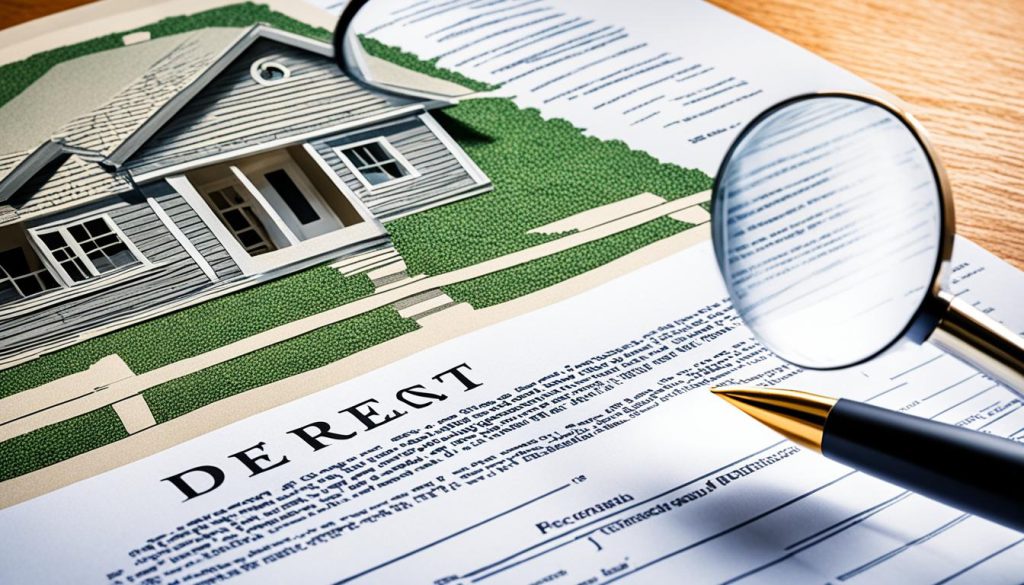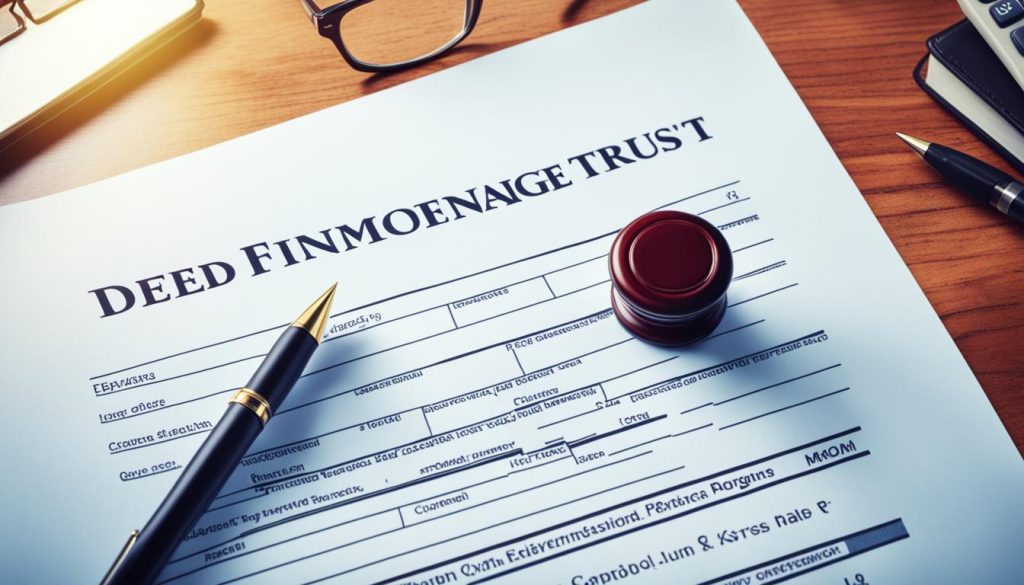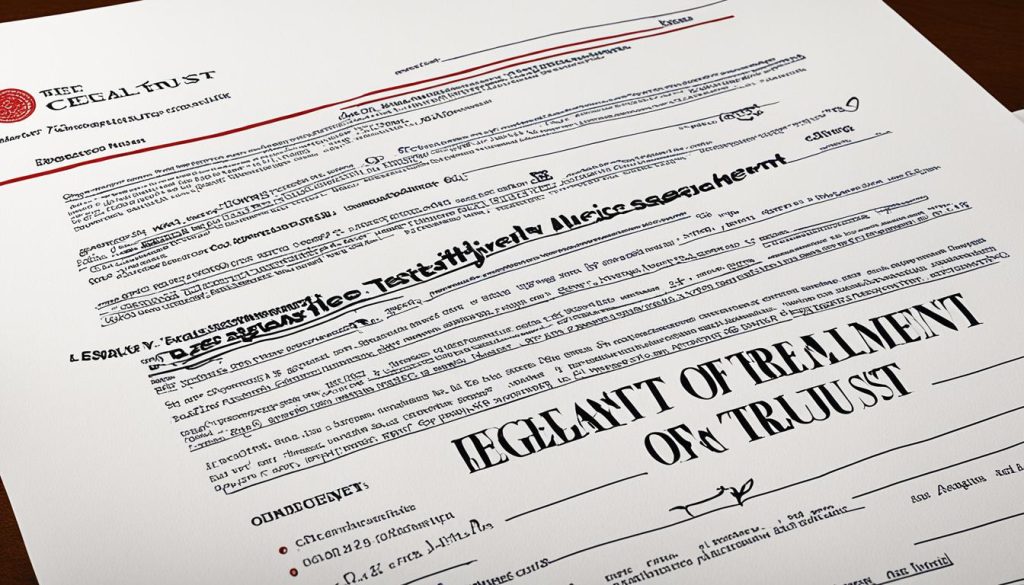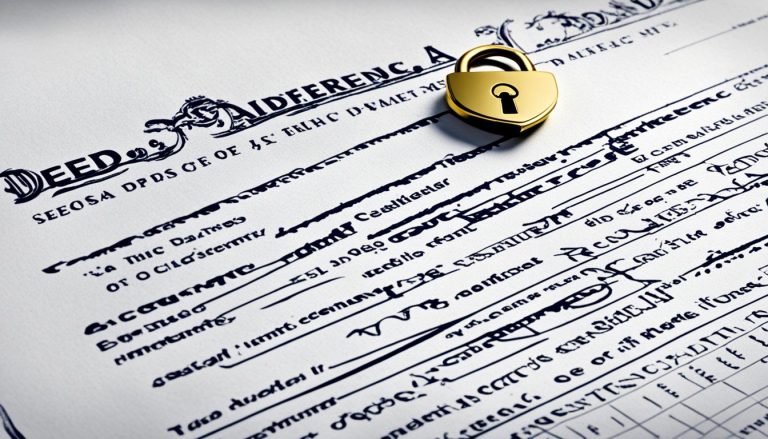Welcome to our article on deed of trust, where we will provide you with a comprehensive explanation and definition of this vital legal document in real estate transactions. If you’re looking to secure a property purchase or finance a real estate deal, understanding the intricacies of a deed of trust is essential.
A deed of trust, also known as a trust deed, is a legally binding agreement that involves three main parties: the borrower, the lender, and a trustee. This document plays a vital role in protecting the interests of all parties involved and provides a secure way to finance property acquisitions and transactions.
Deeds of trust are commonly used in certain states like Alaska, Arizona, California, Colorado, and Texas in the United States. These legal documents offer a streamlined process that safeguards your investment, whether you’re a borrower or a lender.
To get an in-depth understanding of trust deeds and their importance in real estate deals, continue reading our article. We’ll provide you with a detailed explanation of the trust deed process, the benefits it offers, and how it differs from a mortgage. Stay tuned!
What is Deed of Trust?
In real estate transactions, trust deeds play a crucial role in ensuring a secure and efficient process. A trust deed involves three important parties: the lender/beneficiary, the borrower/trustor, and the trustee. This legal document transfers the legal title of a property to a neutral third party, the trustee, who holds it until the borrower repays the loan.
The importance of a deed of trust lies in protecting the interests of both the lender and the borrower. By transferring the property’s title to a trustee, lenders can have confidence that their investment is secure. The borrower, on the other hand, benefits from the opportunity to fulfill their repayment obligations and maintain a sense of ownership of the property.
One of the primary benefits of a deed of trust is the streamlined foreclosure process it offers compared to traditional mortgages. In the case of borrower default, the lender can initiate a non-judicial foreclosure, which is typically faster and less expensive. This speeds up the resolution of the transaction and allows lenders to recover their investment in a more efficient manner.
Additionally, trust deeds provide flexibility in financing real estate transactions. Borrowers can secure loans using the property as collateral, allowing them to access the necessary funds for their purchase. This opens up opportunities for individuals and businesses to invest in real estate and grow their portfolios.
The Deed of Trust Process
The process of creating a deed of trust involves several steps. It starts with the lender and borrower entering into a loan agreement, where the terms and conditions of the loan are defined. The parties then draft the deed of trust document, which includes important details such as the loan amount, repayment terms, and the property’s legal description.
Once the document is finalized, it is recorded with the relevant local authority, such as the county clerk’s office. This step helps establish a public record of the transaction and ensures that all parties involved are aware of their rights and responsibilities.
Throughout the loan repayment period, the borrower makes regular payments to the lender. Once the loan is fully repaid, the trustee releases the property’s title back to the borrower, signifying the successful completion of the transaction.
The table below summarizes the key aspects of the trust deed process:
| Step | Description |
|---|---|
| 1 | Lender and borrower enter into a loan agreement. |
| 2 | Deed of trust document is drafted, including loan details and property description. |
| 3 | Document is recorded with the local authority. |
| 4 | Borrower makes regular payments to the lender. |
| 5 | Loan is fully repaid, and the trustee releases the property’s title to the borrower. |
Understanding trust deeds is essential for anyone involved in real estate transactions. They offer a secure and efficient way to finance property purchases while protecting the interests of all parties involved.

Trust Deed vs. Mortgage
When it comes to real estate financing, trust deeds and mortgages are two commonly used options. While they serve similar purposes, there are key differences between the two. Understanding these distinctions can help borrowers and lenders make informed decisions about their financing options.
A mortgage typically involves two parties: the borrower and the lender. The lender provides the financing, and the borrower pledges the property as collateral. In the event of default, the lender has the right to foreclose on the property to recover their investment. This process typically involves judicial proceedings, which can be time-consuming and costly.
In contrast, a trust deed involves three parties: the borrower, the lender, and the trustee. The trustee acts as a neutral third party who holds the legal title to the property until the loan is fully repaid. This arrangement provides added protection for the lender, as the trustee can initiate a non-judicial foreclosure process in case of default. Non-judicial foreclosures are generally faster and more cost-effective compared to judicial foreclosures.
Furthermore, trust deeds offer lenders greater flexibility and control in dealing with borrower defaults. In the event of default, the trustee can quickly sell the property to recover the outstanding debt. This allows lenders to mitigate losses and avoid lengthy legal proceedings.
Trust deeds are preferred in some states, such as California and Texas, due to their efficiency and cost-effectiveness. They provide lenders with greater protection and borrowers with a streamlined process for obtaining financing. The use of a trust deed can offer peace of mind to both parties involved in a real estate transaction.
Why Use a Deed of Trust?
There are several reasons why borrowers and lenders may choose to use a deed of trust:
- Efficiency: The non-judicial foreclosure process associated with trust deeds allows for faster foreclosure timelines, reducing the time and costs involved in resolving defaults.
- Flexibility: Lenders have greater control and options in dealing with borrower defaults, providing them with more flexibility in recovering their investment.
- Protection: Trust deeds provide added protection for lenders by transferring the legal title of the property to a trustee, ensuring their interests are safeguarded.
- Cost-effectiveness: Trust deeds are often a more cost-effective option compared to mortgages, with shorter foreclosure timelines and reduced legal expenses.
In summary, trust deeds offer distinct advantages over mortgages in terms of efficiency, foreclosure timelines, and lender protection. Their use can provide a streamlined and secure process for real estate financing. When considering a real estate transaction, borrowers and lenders should carefully evaluate their options and assess the benefits of using a deed of trust.
Deed of Trust vs. Mortgage Comparison
| Trust Deed | Mortgage |
|---|---|
| Involves three parties: borrower, lender, and trustee | Involves two parties: borrower and lender |
| Non-judicial foreclosure process | Judicial foreclosure process |
| Quicker and more cost-effective foreclosure timelines | Lengthy and potentially costly foreclosure timelines |
| Greater flexibility and control for lenders in dealing with defaults | Less flexibility and control for lenders in foreclosure proceedings |
| Offers added protection for lenders through the involvement of a trustee | Lender holds the lien on the property |

What is Included in a Deed of Trust?
A deed of trust is a crucial document in real estate transactions that includes important details about the transaction and the loan. It serves as a legally binding agreement between the parties involved and outlines the terms and conditions of the loan. Let’s explore what typically goes into a deed of trust:
1. Names of the Parties Involved
The deed of trust begins by identifying the parties involved in the transaction. This includes the borrower (known as the trustor), the lender (also called the beneficiary), and the trustee. The names of all individuals or entities participating in the agreement are clearly stated.
2. Legal Description of the Property
The deed of trust includes a detailed legal description of the property being used as collateral for the loan. This description ensures that the property is precisely identified, reducing the risk of any confusion or ambiguity.
3. Loan Amount and Repayment Terms
The deed of trust specifies the loan amount provided by the lender and the repayment terms agreed upon by both parties. This includes the interest rate, repayment duration, and the schedule for making payments.
4. Clauses Related to Late Fees, Penalties, and Restrictions
Additionally, the deed of trust may include clauses that address late fees and penalties for missed or delayed payments. It may also outline any restrictions on the use of the property, such as limitations on construction or alterations.
5. Types of Deeds of Trust
There are different types of deeds of trust that can be created depending on the specific requirements of the transaction. For example, a wraparound trust deed combines existing mortgages and creates a new loan to cover the balance. Other types include installment sales deeds and deeds of trust with power of sale.
6. Benefits of Creating a Deed of Trust
Creating a deed of trust ensures that all parties involved are protected and the terms of the loan are clearly defined. It provides a clear process for resolving disputes and enforces the rights and obligations of the borrower and the lender. By creating a deed of trust, the interests of both parties are safeguarded throughout the transaction.

Trust Deeds in Real Estate
Trust deeds serve as essential tools in real estate transactions, providing a means to secure financing for property purchases. By transferring the legal title of a property to a trustee, trust deeds provide a safeguard until the loan is fully repaid. They play a pivotal role in facilitating the smooth acquisition of houses and various other types of properties.
In the United Kingdom, a deed of trust on a property ensures that the property remains in trust until the loan is completely paid off. This arrangement offers peace of mind to both borrowers and lenders, as it establishes a clear framework of security and accountability throughout the real estate transaction.
First and foremost, trust deeds are used to secure funding for property purchases, enabling buyers to complete their transactions with confidence. By entrusting the legal title of the property to a trustee until the loan is satisfied, trust deeds provide a layer of protection for all parties involved.
Whether it is a residential house or a commercial property, trust deeds ensure that the lender’s interests are safeguarded, mitigating the risks associated with default or non-payment. Moreover, trust deeds offer borrowers the opportunity to secure financing and fulfill their ownership aspirations while adhering to mutually agreed-upon repayment terms.
Image:
To illustrate, let’s consider a hypothetical scenario where a buyer wishes to purchase a house. The buyer secures a loan from a lender and, in return, offers a trust deed, transferring the legal title to a trustee. The trustee holds the property in trust until the loan is fully repaid. This ensures that the lender has a legal claim to the property in case of default, while also providing the buyer with the means to complete the purchase.
In summary, trust deeds are invaluable tools in real estate transactions, playing a pivotal role in enabling property purchases. By using a deed of trust, individuals can confidently navigate the process of acquiring real estate while protecting the interests of all parties involved.
Investing in Trust Deeds
Investing in trust deeds can be a lucrative option for those seeking high-yielding income streams. Trust deed investing involves lending money to developers for real estate projects, making investors the lenders with their names recorded on the trust deed. This form of investment offers attractive benefits, including portfolio diversification and passive income opportunities.
One of the primary benefits of investing in trust deeds is the potential for high returns. Investors earn interest on their investment and receive their principal back once the project is completed. This can result in a steady income stream that surpasses other traditional investment options.
Additionally, trust deed investing provides an alternative to the stock market, offering potentially more stable returns and protection against market volatility. By diversifying their investment portfolio to include trust deeds, investors can reduce their exposure to market risks and navigate through uncertain economic times more effectively.
Furthermore, investing in trust deeds allows individuals to contribute to local real estate development while generating financial returns. By providing developers with the necessary funds to complete their projects, investors support the growth of their communities and contribute to the overall economic development.
However, it is important to note that investing in trust deeds also comes with certain risks. One significant risk is the illiquidity of these investments. Unlike stocks or bonds, trust deeds are not easily traded or sold on an exchange. Investors must be prepared to hold their investment until the project is completed and the principal is repaid.
In addition, trust deed investments may have limited capital appreciation potential compared to other real estate investment options. The primary focus of trust deed investing is generating regular interest income rather than seeking substantial capital gains.
To make an informed investment decision, it is essential for individuals to carefully evaluate the potential benefits and risks associated with trust deed investing. Assessing personal financial goals, risk tolerance, and consulting with a qualified financial advisor are essential steps to consider before engaging in trust deed investments.
Key Benefits of Investing in Trust Deeds
- High-yielding income streams
- Portfolio diversification
- Passive income opportunities
- Supporting local real estate development
Despite the risks, trust deed investing can be an attractive investment strategy for those seeking stable income and diversification within the real estate market.
Image: Investing in trust deeds can provide high-yielding income streams and diversification opportunities in real estate investments.
Real-World Example of a Trust Deed
A real-world example of a trust deed can be seen in the short form deed of trust document used in Austin County, Texas. This document covers the necessary requirements for most lenders and includes important clauses related to payment, escrow funds, liens, and property maintenance. It also outlines the transfer of property rights and specifies that the loan is not a home equity loan. This example highlights the importance of a well-drafted trust deed that includes all the necessary details and protections for both the borrower and the lender.
When examining the trust deed process, it is crucial to have a concrete understanding of its application in a real-world scenario. An example provides valuable insight into how a trust deed functions and the essential elements it encompasses. The trust deed document utilized in Austin County, Texas acts as a prime illustration of a well-crafted trust deed.
Key Components of the Deed of Trust Example
The deed of trust example utilized in Austin County, Texas includes vital components that serve to protect both parties involved in the real estate transaction. These key elements are as follows:
- Payment: The trust deed specifies the payment terms, ensuring clarity and enforceability regarding the borrower’s repayment obligations.
- Escrow Funds: Clauses related to escrow funds are included in the trust deed, ensuring that funds are allocated appropriately for taxes, insurance, and other related expenses.
- Liens: The trust deed example outlines the requirements for any existing liens or encumbrances on the property, providing transparency to all parties involved.
- Property Maintenance: This clause emphasizes the borrower’s responsibility for maintaining the property, ensuring proper upkeep throughout the loan term.
- Transfer of Property Rights: The trust deed clearly delineates the transfer of property rights from the trustee to the borrower upon full repayment of the loan, ensuring a smooth transition.
- Loan Classification: The trust deed example explicitly states that the loan is not a home equity loan, providing clarity on the type of financing involved in the transaction.
This real-world example of a trust deed emphasizes the importance of a well-drafted trust deed document that encompasses all the necessary details and protections. It serves as a valuable guide for lenders and borrowers alike, ensuring a secure and transparent real estate transaction.
Conclusion
In conclusion, a deed of trust is a crucial document in real estate transactions. It provides a secure way to finance the purchase of properties and protects the interests of both borrowers and lenders. Trust deeds offer several advantages over mortgages, including a streamlined foreclosure process and faster timelines.
These documents include important details about the transaction and the loan, ensuring that all parties involved are protected. It is essential to carefully consider the importance of a deed of trust before entering into a real estate agreement. Whether you are a buyer or a lender, understanding the deed of trust explanation and definition is vital to make informed decisions and safeguard your interests.
Investing in trust deeds can be a profitable venture, providing high-yielding income streams through real estate projects. However, it’s important to keep in mind the potential risks associated with trust deed investments, such as illiquidity and limited capital appreciation. Before diving in, evaluate the benefits and drawbacks of trust deed investments and assess your personal risk tolerance.






